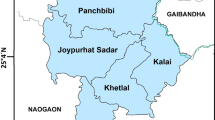Abstract
Modeling and forecasting groundwater level is useful to develop managerial activities. This study was carried out to evaluate the wavelet-time series models to estimate groundwater levels. First, three time series models, i.e., autoregressive moving average (ARMA), autoregressive integrated moving average model (ARIMA), and SARIMA were used in their single form to predict groundwater level for different time steps in two sub-basins in Mashhad plain, Iran. In the next step, these models were combined with transformation. Results showed that the single models do not have a strong ability to cope with the non linearity and seasonality behavior of data. However, combination of these models with wavelet transformation could improve groundwater level modeling. Results showed that wavelet-SARIMA hybrid model had the best performance. In addition, it is concluded that all modeling approaches are satisfactory only to forecast groundwater level for 1 and 2 months ahead. This study also showed that these models forecasted groundwater level for 1 and 2 months ahead accurately but their accuracy decreases for 3 and 4 months ahead.


Similar content being viewed by others
References
Adamowski J, Fung Chan H (2011) A wavelet neural network conjunction model for groundwater level forecasting. J Hydrol 407:28–40
Adamowski J, Sun K (2010) Development of a coupled wavelet transform and neural network method for flow forecasting of non-perennial rivers in semi-arid watersheds. J Hydrol 390(1–2):85–91
Aladag CH, Egrioglu E, Kadilar C (2009) Forecasting nonlinear time series with a hybrid methodology. Appl Math Lett 22(9):1467–1470
Chen KY, Wang CH (2007) A hybrid SARIMA and support vector machines in forecasting the production values of the machinery industry in Taiwan. Expert Syst Appl 32(1):254–264
Christopoulou EB, Skodras AN, Georgakilas AA (2002) The “Trous” wavelet transform versus classical methods for the improvement of solar images. In: In: Proc. 14th International Conference on. Dig Signal Proc. 2., pp 885–888
Daliakopoulos I, Coulibalya P, Tsani IK (2005) Groundwater level forecasting using artificial neural network. J Hydrol 309:229–240
Deng X, Wang X (2009) Incremental learning of dynamic fuzzy neural networks for accurate system modeling. Fuzzy Sets Syst 160:972–987
Erdem E, Shi J (2011) ARMA based approaches for forecasting the tuple of wind speed and direction. Appl Energy 88(4):1405–1414
Faruk D (2010) A hybrid neural network and ARIMA model for water quality time series prediction. Eng Appl Artif Intel 23(4):586–594
Graves D, Pedrycz W (2009) Fuzzy prediction architecture using recurrent neural networks. Neural Comput 72:1668–1678
Grossman A, Morlet J (1984) Decompositions of hardy functions into square integrable wavelets of constant shape. J Math Anal 15:723–736
Jain A, Kumar A (2006) An evaluation of artificial neural network technique for the determination of infiltration model parameters. Appl Soft Comput 6:272–282
Kisi O (2009) Neural networks and wavelet conjunction model for intermittent streamflow forecasting. J Hydrol Eng 14:773–782
Mallat SG (1989) A theory for multi resolution signal decomposition: the wavelet representation. Trans Pattern Anal Mach Intell 11:674–693
McNeil AJ, Frey R, Embrechts P (2005) Quantitative risk management: concepts, techniques, and tools. Princeton University Press, Princeton
Moosavi V, Vafakhah M, Shirmohammadi B, Ranjbar M (2013a) Optimization of wavelet- ANFIS and wavelet-ANN hybrid models by Taguchi method for groundwater level forecasting. Arab J Sci Eng 39:1785–1796
Moosavi V, Vafakhah M, Shirmohammadi B, Behnia N (2013b) A Wavelet-ANFIS Hybrid Model for Groundwater Level Forecasting for Different Prediction Periods. Water Resour Manage 27:1301–1321
Moosavi V, Malekinezhad H, Shirmohammadi B (2014) Fractional snow cover mapping from MODIS data using wavelet-artificial intelligence hybrid models. J Hydrol 511:160–170
Nourani V, Alami MT, Aminfar MH (2009) A combined neural-wavelet model for prediction of watershed precipitation, Lighvanchai, Iran. Eng Appl Artif Intell 16:1–12
Pai PF, Lin CS (2005) A hybrid ARIMA and support vector machines model in stock price forecasting. Omega 33(6):497–505
Partal T (2009) River flow forecasting using different artificial neural network algorithms and wavelet transform. Can J Civ Eng 36:26–38
Prinos ST, Lietz AC, Irvin RB (2002) Design of a real-time groundwater level monitoring network and portrayal of hydrologic data in southern Florida. USGC Water Resour Invest Rep 01–4275
Shirmohammadi B, Moradi HR, Moosavi V, Taie Semiromi M, Zeinali A (2013a) Forecasting of meteorological drought using Wavelet- ANFIS hybrid model for different time steps (case study: southeastern part of east Azerbaijan province, Iran). Nat Hazards 69:389–402
Shirmohammadi B, Vafakhah M, Moosavi V, Moghaddamnia A (2013b) Application of several data-driven techniques for predicting groundwater level. Water Resour Manag 27:419–432
Weng H, Lau KM (1994) Wavelets, period doubling, and time-frequency localization with application to organization of convection over the tropical western Pacific. J Atmos Sci 51:2523–2541
Wong H, Zhang R, Xia J (2007) Non-parametric time series models for hydrological forecasting. J Hydrol 332(3–4):337–347
Yasuri M (2006). The study of regional GIS of Mashhad. Research plan of ferdowsi university of mashhad. 159p. (In Persian)
Zhang GP (2003) Time series forecasting using a hybrid ARIMA and neural network model. Neurocomputing 50:159–175
Zhao L, Yang Y (2009) PSO-based single multiplicative neuron model for time series prediction. Expert Syst Appl 36:2805–2812
Author information
Authors and Affiliations
Corresponding author
Rights and permissions
About this article
Cite this article
Behnia, N., Rezaeian, F. Coupling wavelet transform with time series models to estimate groundwater level. Arab J Geosci 8, 8441–8447 (2015). https://doi.org/10.1007/s12517-015-1829-0
Received:
Accepted:
Published:
Issue Date:
DOI: https://doi.org/10.1007/s12517-015-1829-0




